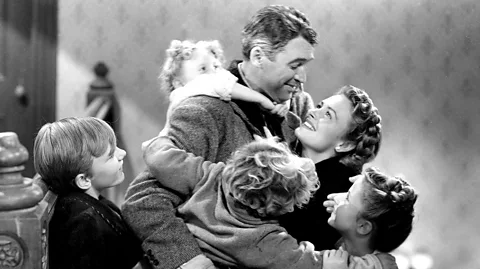 Alamy
AlamyReleased in 1946, Frank Capra’s It’s a Wonderful Life was derided as an “over-sentimental” Christmas yarn. In History looks at how its profound exploration of mental health, societal expectations and the healing power of community resonates today.
In the eight decades since its release, It’s a Wonderful Life has become a sacrosanct part of the holiday period. James Stewart stars as George Bailey, a savings and loans manager who contemplates taking his own life until an angel shows him a vision of how much worse off his town and his loved ones would be if he had never been born. Due to a clerical oversight, the film’s copyright expired in 1974, and the subsequent television broadcasts cemented its reputation as a Christmas classic. And yet, even in 1974, its director Frank Capra was still having to defend it from the charge of being “over-sentimental”.
“I think it was probably the strongest picture I’ve made,” Capra told a BBC reporter in an episode of Film Extra. “I think it’s my favourite film because it epitomises everything I tried to say in all the other films in one package.”
On its release in 1946, Bosley Crowther of The New York Times critiqued It’s a Wonderful Life for its tone, noting that “the weakness of this picture is the sentimentality of it”. Capra’s earlier film-making was similarly associated with sentimental, idealised versions of US life. Works such as Mr Deeds Goes to Town and Mr Smith Goes to Washington were labelled “Capra-corn” because of their sweet, unassuming nature. However, while It’s a Wonderful Life concludes with pure-hearted George winning out over the greed-ridden Mr Potter (Lionel Barrymore), the film exposes the grim, unspoken struggles of the ordinary man. In an era of masculine stoicism, when mental health went largely undiscussed, Stewart’s portrayal of George’s desperation addressed issues of anxiety, depression and the sense of personal failure.
The regular everyman he played was also a departure from his earlier heroic roles, marking the transformation of his persona both on and off screen. In 1973, he would describe his on-screen persona on Michael Parkinson’s chat show. “I’m the plodder. I’m the inarticulate man that tries. I’m a pretty good example of true human frailty. I don’t really have all the answers. I have very few of the answers, but for some reason, somehow, I make it. I get through.”
George’s specific personal struggles may not have been shared by Stewart, but as a veteran not long back from World War Two, the actor had his own mental health issues. “It’s the first picture I did after I got out of the service,” Stewart told BBC audiences in 1972. It would be almost four decades before post-traumatic stress disorder (PTSD) would be added to the Diagnostic and Statistical Manual of mental disorders (DSM). Veterans were often diagnosed with “shell shock” or “combat fatigue” and faced many difficulties while reintegrating back into civilian life.
‘I broke down sobbing’
In an era of stiff upper lips, Stewart’s performance was vulnerable, emotionally honest, and sometimes devastating. Near the beginning of the film, George prays for help while drinking in a bar in the fictional town of Bedford Falls, New York – and he begins to weep. He considers himself a failure. After a life of putting his personal dreams aside, and making sacrifice after sacrifice, he has lost all sense of self-worth.
George’s tears in this scene were Stewart’s own, genuine and unplanned. He would later explain in a 1987 retrospective for Guideposts, “As I said those words, I felt the loneliness, the hopelessness of people who had nowhere to turn, and my eyes filled with tears. I broke down sobbing.” Stewart’s authentic emotions transcend the stigmas of his day. George’s inability to seek help and his overwhelming sense of failure spoke of an era in which emotional problems were seen as shameful or insignificant. But what was once written off as sentimentality finds new and greater appreciation amid today’s conversations surrounding mental health.
Mary Hatch Bailey (Donna Reed), George’s childhood sweetheart and devoted wife, also reflects the role expected of her at the time, in that she largely acts according to traditional views of womanhood. Like George, she is a selfless character, making many of the same sacrifices as her husband and helping him however she can. But while we follow George’s life, setbacks and inner turmoil, Mary’s go unexplored. Unlike the prominent women in earlier Capra films who assert their independence, Mary is a force of quiet, unwavering support. She plays a crucial role in George’s salvation, but her efforts go unsung. The film’s attitude towards women can also be seen in Mary’s fate in the alternate reality where George was never born. In the nightmarish Pottersville, where death, greed, and abuse have befallen George’s closest friends, Mary’s supposedly terrible life is simply that of an unmarried, bespectacled librarian.
The other most prominent women in the film, George’s mother and his childhood friend, adhere to these same societal expectations. Irene Bailey (Beulah Bondi) is a steadfast mother with little screentime, while the flirtatious vixen Violet Bick (Gloria Grahame) acts as a foil to the responsible, honourable Mary. After George’s outburst to his frightened family, it is Mary who encourages their children to pray for him. In this way, she has a direct hand in the divine intervention he experiences in the form of Clarence Odbody, the wingless angel.
But Mary isn’t alone. Clarence is sent to George because of the prayers of all the people he touched during his life in Bedford Falls. In this way, Clarence is a manifestation of the support and kindness George has given to the town. His salvation ultimately comes in the final scene, when his family and friends arrive to alleviate his financial burdens. In this climactic moment, his troubles are mitigated by the very community he has helped to build. This cathartic act illustrates the profound healing power of community and a sense of belonging.
It’s a Wonderful Life explored the toll of sacrifice, the ripples of kindness, and the salvation offered by human connection at a time when films tended to prioritise optimism over psychological complexity. George’s doubts about his own self-worth, given authenticity by Stewart’s portrayal, resonate in today’s world with its ongoing challenges related to mental health, economic hardship and societal pressures. It is in seeing his life through a different lens, sharing his burdens and accepting help from his community that George accepts the truth. He is not alone, his life has not been futile and he is not worthless. As his brother Harry says in a toast at the end of the film, George Bailey is “the richest man in town”.
For more stories and never-before-published radio scripts to your inbox, sign up to the In History newsletter, while The Essential List delivers a handpicked selection of features and insights twice a week.






Leave a Reply